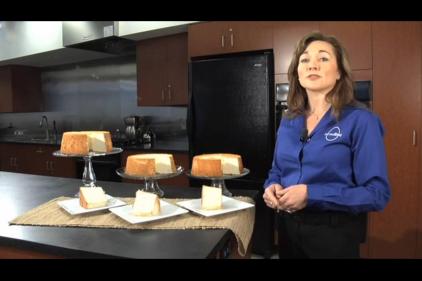Editor’s note: This article is derived from a recent workshop “Aeration in Baked Goods: Using Eggs to Create Foams,” conducted during the National Egg Products School by Shelly McKee, Ph.D. of Auburn University, Ala., in which she showed how bakers can best use eggs to create optimal foams. McKee began with background information that included deeper understanding of the components of the whole egg as well as its main parts, the white and the yolk and their subcomponents.
Eggs undergo a series of physical and chemical changes after leaving the hen. They begin to lose water and become more basic as the pH level rises from 7 to 9, thinning the egg white and weakening the yolk membrane. Storage at room temperature or high temperatures increases the rate of these chemical changes. The changes also negatively influence the quality of the egg proteins and thereby diminish the egg’s functional properties. On a solids basis, egg white is almost entirely protein—the purest and most bioavailable protein of any food source—and practically the sole source of these egg proteins. These include conalbumin, globulins, ovalbumin and ovomucin. It is these proteins that enable egg whites to be whipped into a foam that can reach up to six to eight times greater volume than the unwhipped, liquid egg white. No other natural food ingredient can create as large of a food foam as egg white.
To best understand how all egg products can entrap air, it is important to understand their protein composition. The viscosity of all egg products is ideal for incorporating air cells during whipping or beating. However, dried egg whites need to be blended with a carbohydrate to increase solubility before hydration and subsequent whipping or beating. As whipping or beating progresses, air bubbles simultaneously decrease in size and increase in number, as the bubbles remain surrounded by egg proteins.
Egg whites are superior foaming agents because egg whites have a low air-to-liquid interfacial tension. Thus, when beaten or whipped the proteins become denatured—that is, their structure unfolds. This exposes two oppositely charged ends of the protein molecule—the hydrophobic, or water-repelling end, and the hydrophilic, or water-attracting end. The proteins align themselves between the air and water, forming bubbles with their hydrophilic chains pointing into the water phase, and their hydrophobic chains pointing to the air phase.
During baking, these proteins bond with each other, forming a delicate, yet reinforced network that strengthens the baked goods, and enables it to maintain volume. But the proteins in whites do all of this much better than the proteins in the yolk or even when in whole egg form. Ovalbumin, which makes up about 54% of the white’s protein content, coagulates when heated, forming a solid framework around entrapped air that enables the wall structure to resist collapse.
Ovalbumin is responsible for original foam volume when egg whites are whipped. Ovomucin is responsible for holding onto the air bubbles during heating and has elastic qualities that allow the protein to stretch as the air bubbles enlarge. This “division of labor” between these two protein forms is not absolute. Some ovalbumin probably helps with the initial foaming, and the other proteins eventually coagulate in the oven. But these two proteins act as functional specialists to a large extent and, without them, egg white foams would not be the powerhouses they are.
A number of variables can impact the stability of egg white foams. First, it is possible to overbeat egg white foams. When this happens, the proteins denature and are prevented from entrapping air. For example, when properly beaten egg white is used in a soufflé, the baking process slowly expands the air bubbles, which are surrounded by the egg white proteins, giving the soufflé its signature puff. Extreme overbeating breaks the set protein bonds, the air escapes and the foam loses volume. If egg white foam stands for more than five minutes, air starts to escape and it quickly collapses and returns to its liquid state. A little bit of a recipe’s sugar content can be added during foam preparation to prevent air from escaping. If added properly, the result is a smooth, stable foam that does not collapse or drain as quickly as a foam without added sugar. However, sugar can also retard foaming if too much is added, or if it’s added too fast.
Traditionally, bakers and chefs used copper bowls to stabilize egg white foams. The copper in the bowl combines with conalbumin and helps to stabilize the protein during heating. Today, a more common approach to stabilizing egg white foam is to add cream of tartar, known chemically as potassium bitartrate. This chemical salt lowers the pH of the egg white, which shortens the time necessary to form a foam.
Temperature also impacts the volume of egg white foam. Egg whites reach their greatest volume if beaten at closer to room temperature than at refrigerated temperature. This reduces the surface tension so the whites can foam more easily. It also is helpful to remember that beating time is directly related to temperature—the colder the whites, the longer the beating time. These aspects also can establish greater risk for overbeating.
There are a number of other variables that affect egg white foam stability. Salt can decrease the foam’s stability by weakening the matrix of the protein bonds. It is best to add salt to a recipe along with other dry ingredients because it helps unwind proteins during initial foaming. Pasteurization increases whip time and hen age has an impact, with older hens laying eggs with less solids (protein proportionally to other components) than young hens. Old eggs with thin, watery albumen will produce poor foam stability, while increased solids increase foam volume and stability. This is because proteins are more functional at a pH close to 7.0 and less functional at a pH near 9.0.
Temperature during foam formation makes a difference—egg whites achieve quicker foaming at room temperature, but too much heat generated early during foam formation can weaken foams. Heat during cooking leads to protein denaturation, setting final structure too soon. Too much water can increase the volume and lightness of a foam, although there is a greater likelihood that some liquid will drain off due to the dilution of proteins. Further, egg white diluted by 40% or more of its volume in water cannot produce a stable foam.
Flour and sugar help to stabilize structure and give texture, and gums stabilize foams, helping to prevent moisture loss (syneresis and meringue shrinkage). Citric acid (0.11%) will improve egg-white protein functionality by reducing pH and stabilizing product color. Surfactants will ease foaming. For example, sodium lauryl sulfate (<0.1%) is added to dried egg whites to reduce surface tension and enhance foaming. Esters such as triethyl citrate (0.25%) added to high-whip liquid egg whites will reduce surface tension, ease foaming and decrease whip time.
There is no ingredient as detrimental to an egg-white foam as fat. Even a trace amount will block foaming action. This is because fat molecules have hydrophobic and hydrophilic ends as do proteins. Fat competes with protein for special alignment with gas bubbles. But unlike proteins, fats don’t create a stable structure. They won’t create any cross-linked bonds to reinforce the network of gas bubbles. Instead, fat molecules continue to compete with protein molecules in forming bonds. When even the slightest amount of fat—any type of fat-butter, cream, residual cooking oil on the mixing bowl or beater, or even a drop of egg yolk comes in contact with egg white—the foam will never achieve its full potential.
Shelly McKee is an associate professor in the Department of Poultry Science at Auburn University in Auburn, Ala. To learn more about eggs in formulation (especially egg-white aeration and foam formation), check out her video series at www.functionalegg.org.








